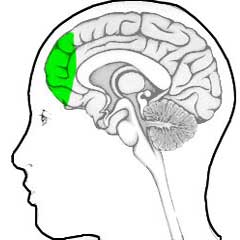I can’t tell you how many times I have been asked the question, “What part of the brain can we tap into for more motivation? Is there a spot that we can focus on?”
That is a hard question to answer, because motivation comes from within; within the mind, body, and spirit. Research shows that both motivation and attention are controlled by the prefrontal cortex, which can be thought of as the “executive center” of the brain.

The prefrontal cortex, which continues to mature into early adulthood, controls functions such as planning, decision making and the ability to delay gratification.
There is a whole chapter on ‘Attention and Motivation’ in The Dana Guide to Brain Health, a great resource for anyone looking for more information, that explains the prefrontal lobe are its role in formulating complex goals and intentions. The authors note that “this means that the human brain is capable of creating models of the world not only as it is, but as we want it to be. The human brain is able to create models of the future. This is called intentionality. But merely creating a model of the future is not enough. We must have the ability to strive to change the world as it is into the world we want it to become. This ability is called motivation. Without motivation, no life challenge of any degree of complexity can successfully be met.”
We use the frontal lobes to set our short and long term goals, as well as to prioritize and keep our attention from being distracted from our goals. There is more to motivation that just setting a goal, as everyone is not goal oriented. Different people get motivated in different ways. For some people, motivation must come through positive reinforcement, such as:
- Killing them with kindness; showering them with support. A positive brain approach.
- Treating them with trust and respect.
- Creating challenges. Getting them excited!
- Incentives and rewards.
- Inspiring them – make them believe in themselves.
Inspiration – stimulating our mind and emotions to a high level of feeling and activity. Many of us can be inspired by the words of great leaders. One that rings especially true for me comes from Gandhi, who said “You must be the change you wish to see in the world.” We may get inspiration from a speech we hear, a story we read, or a simple act of kindness that we see during our daily lives. Poetry moves us in different ways. Music is a powerful vehicle for motivation; just ask anyone who feels the beat of their favorite song fueling them to run that extra lap, or work just a little bit harder the next time they exercise.
For me, motivation occurs on all levels, cognitively, emotionally and spiritually. I want to share this video with you that provided the inspiration for this blog. Just watch it. Texas County Reporter: Blind Quilter It will touch you in a way you didn’t expect.
Go explore your local library, the internet, or even ask your friends and family for sources of inspiration. Find something that rings true for you personally, and use that as your own personal call to arms, as your mantra to spur you forward towards healthy behaviors. However, if you still find yourself saying “none of that works for me, no matter how hard I try” and you feel out of control, you should stop blaming yourself and start wondering. Ask yourself, could there be a medical reason? Is your brain out of balance and not working the way it needs to? Are you depressed? These are questions that require investigation. If you think you were born that way and can’t change it, you are wrong. You can. Seek the help of a neurologist or neuropsychologist who can provide you with the tools and treatment to help you heal yourself.
You can create positive change in your life!
